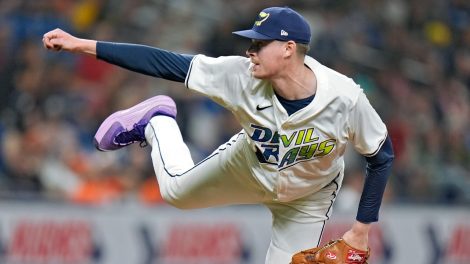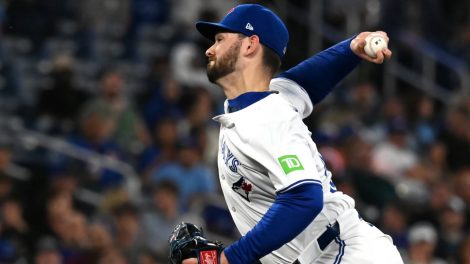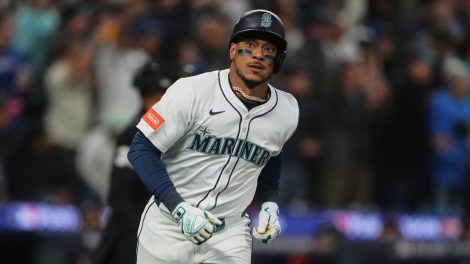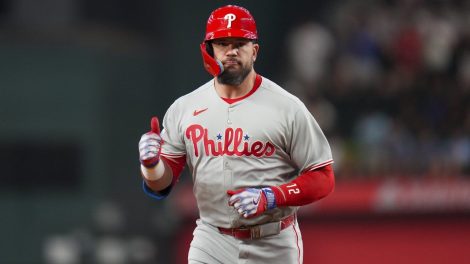TORONTO – Some early hints at the Blue Jays’ off-season planning emerged Thursday and though priorities could clearly change with nearly one-third of the regular season remaining, it’s already apparent that the club will be targeting pitching.
More specifically, the Blue Jays expect to spend ‘the bulk’ of their resources on starting pitching this off-season, according to president and CEO Mark Shapiro. Some bullpen pieces will probably join the Blue Jays, too.
As a promising core of position players establishes itself in the majors, the Blue Jays feel ‘a sense of urgency to win,’ Shapiro said. In 2020, the club hopes that core progresses from competing to winning.
“We will certainly have to and will supplement that internal group of players, look to do it as soon as this off-season,” he said. “But it’s not a great off-season for free-agent talent.”
With all kinds of payroll flexibility available and a clear need for pitching, the Blue Jays will surely be active in free agency this winter. But Shapiro described the front office approach as ‘opportunistic,’ suggesting modest deals are more likely than a pursuit of, say, Gerrit Cole.
[snippet id=4545751]
Entering Thursday’s series against the Yankees, the Blue Jays were on pace to lose 97 games. At this point, the front office might decide it’s still too early to spend at the top of the free agent market.
“All wins aren’t created equal, right?” Shapiro said. “So a player who’s a three-win player who takes you from 82 to 85 wins probably doesn’t move that needle. But if you’re at 87 wins and it takes you from 87 to 90, does that make sense? So it’s more like when we’re at that point, when you can get the player who helps take you from a good team to a team that’s a potential championship team, we need to go out and get that player, and that (ownership) support will be there.”
Of course, we’re months away from any sort of free agent activity, and the results of the next seven weeks will shape the Blue Jays’ plans to some extent. Until then, here are some more observations from Shapiro’s hour-long discussion with Toronto-based writers…
[snippet id=3305549]
On delays in Dunedin:
Construction at the Blue Jays’ Dunedin, Fla. site won’t be fully completed for spring 2020, as initially anticipated. While renovations at Dunedin Stadium are on track, it’ll take longer to finish the multi-purpose building that will eventually serve as the team’s clubhouse, training and development centre.
“We would have liked to think we would have been in that building, in the player development complex, but a 100,000 square foot training centre, which will be I think the best in all of major-league baseball is going to take a little bit longer to finish,” Shapiro said.
Once completed, Dunedin Stadium will have new dugouts, a wider selection of concessions and a boardwalk that encircles the entire field.
On the high performance department:
Nearly four seasons after the Blue Jays first implemented their high performance department, Shapiro’s pleased with the club’s venture into sports science. The opportunities there are ‘endless,’ he said, with a ‘huge amount of upside.’
There is one thing Shapiro would have done differently, however. When the Blue Jays introduced the department before the 2016 season, they were early adopters relative to much of major-league baseball. As such, the announcement drew plenty of attention, including criticism from outside and inside the organization.
“I think probably the biggest mistake we made was calling that the high performance department,” Shapiro said.
Even if the resources offered within the department help players eat, sleep, prepare and feel better, the ‘high performance’ label may have created unnecessary resistance. Regardless of what you call it, the Blue Jays believe their sports science division helps their players stay on the field and play at the peak of their abilities.
And for those wondering, Shapiro said high performance does not determine who sits and who plays.
“Charlie (Montoyo) does that 100 per cent,” Shapiro said. “It’s the manager. One hundred per cent. Ross (Atkins) doesn’t make out the lineup, HP doesn’t make out the lineup, Charlie makes out the lineup.”
On the potential of change at Rogers Centre:
On many occasions during his tenure as club president, Shapiro has spoken about the need for large-scale changes at baseball’s seventh-oldest stadium. Those discussions are still underway, but are ‘largely driven’ by Rogers Communications Inc., which owns the team. For now, the Blue Jays will continue maintaining the building and striving for smaller-scale improvements.
“I feel like we’re getting closer to (larger changes), but we’re not quite there yet,” Shapiro said. “In the meantime, as an operator of the team, my job is to make sure that this stadium continues to both be safe and have the best infrastructure and we continue to improve fan-facing amenities as well.”
[relatedlinks]
On Ross Atkins’ work as general manager:
“I never look at it as one person, it’s Ross, it’s Joe (Sheehan), it’s Mike (Murov), it’s Gil (Kim), it’s Ben (Cherington), it’s Angus (Mugford). It’s a large group of people (and) they’ve done a good job both of working and building off of the great things that were already in place, and supplementing what we needed in talent and systems. They’ve positioned the team extremely well, regardless of what happens, for the future.”
On Charlie Montoyo’s work as manager:
“I look at Charlie and the staff collectively. It’s rare you see the level of teaching, developing, the positive energy, the positive attitude that’s happened this year throughout the ups and downs. Charlie is going to continue to grow, as I hope any professional would, as I hope I do, in his role and get better and better. Already he’s shown tremendous signs and he’s been incredibly positive and he’s done a very good job.”
On watching Nate Pearson’s workload:
“It’s about ensuring he has a foundation to not just be exciting the day he gets here, but be able to contribute at a major-league level, which means hopefully pitching 175-200 innings. Innings jumps are where the biggest danger and red flags happen when guys get hurt. There’s no science to the number of pitches and pitch counts. Jumps in innings, over time, pretty clearly demonstrate major injury risk. We’ve been careful, we’ve had a plan all year of how to stagger the amount of innings he makes in his starts and we’ll have to think about that moving forward with his transition to the major-league level as well.”








